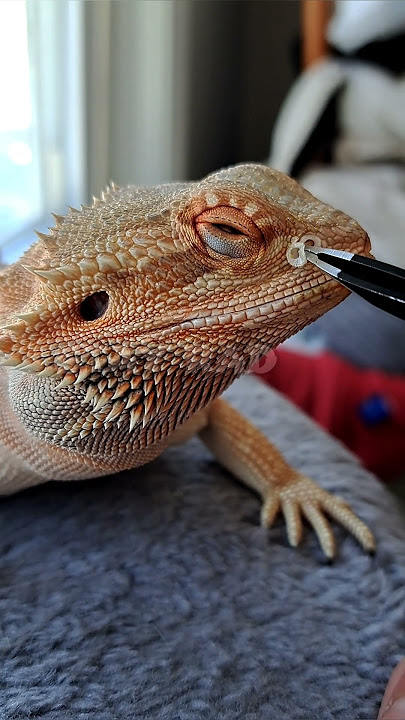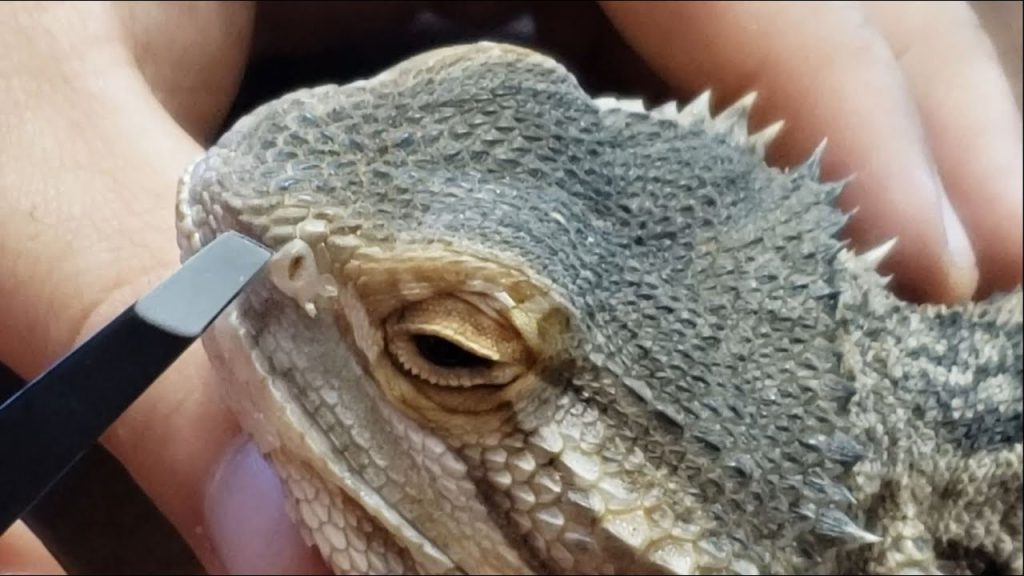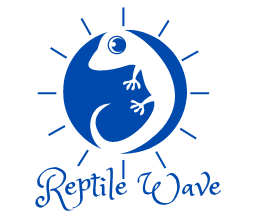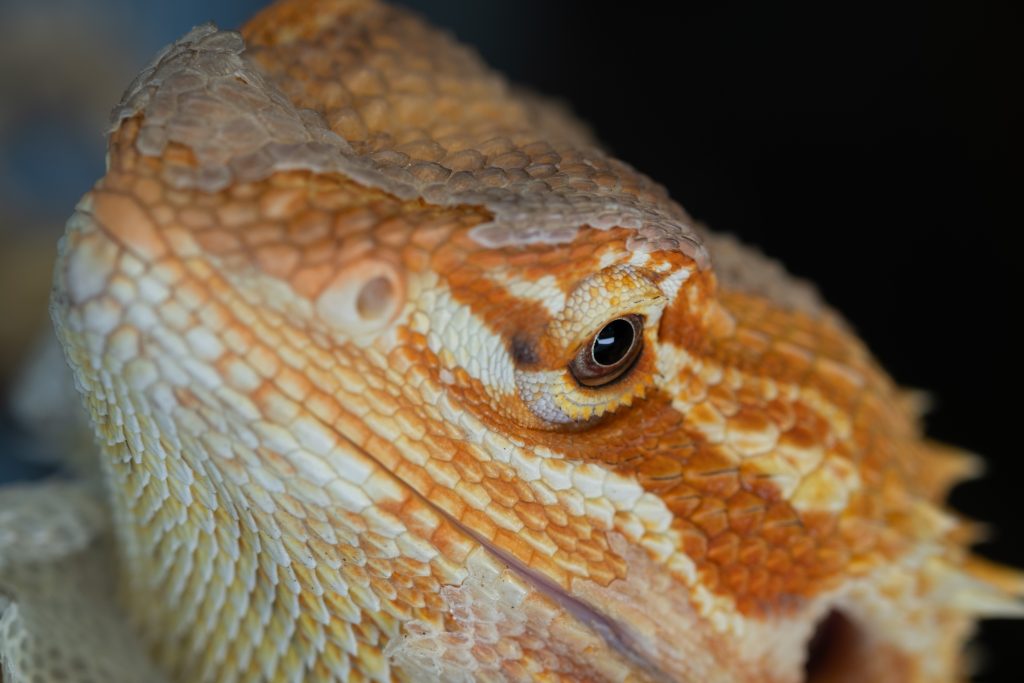Bearded dragons, like many reptiles, shed their skin regularly as they grow. Shedding can occur on various parts of the body, including the nostrils. When a bearded dragon is about to shed, you may notice changes in its behavior and appearance.
If you observe that your bearded dragon’s nostrils are about to shed, there are a few things you can do to help facilitate the process and ensure that the shed goes smoothly.
To make shedding easier:
- Maintain proper humidity in the enclosure.
- Provide a humid hide with moistened substrate.
- Ensure a well-balanced diet for overall health.
- Minimize handling during the shedding period.
- Monitor for complications, such as a retained shed, and seek veterinary advice if needed.
What Signals Nostril Shedding in Bearded Dragons?

When bearded dragons grow, they shed their skin, including around their nostrils. Here are some signs that a bearded dragon might be getting ready to shed:
- Dull Skin: The skin around their nostrils might look dull or change color.
- Moving Around More: They might seem restless or move around more than usual.
- Not Eating Much: Sometimes they don’t eat as much before shedding, but this usually goes back to normal afterward.
- Cloudy Eyes: Their eyes might look cloudy a few days before shedding.
- Taking More Baths: They might spend more time in their water dish or bath.
- Rubbing or Scratching: They might rub their noses or scratch at their nostrils.
- Peeling Skin: You might see skin peeling or flaking around their nostrils.
How to Support Nostril Shedding in Bearded Dragons?
By paying attention to these things, people taking care of bearded dragons can help them feel good while they’re shedding their skin.
Maintaining Proper Humidity
Bearded dragons, especially during shedding, thrive in environments with humidity levels between 30-40%. Striking this balance is crucial to prevent both excessive dryness and high humidity, which can lead to respiratory issues.
Regular misting of the enclosure using a fine spray helps elevate humidity. Pay particular attention to the nostril area to ensure it remains adequately moist for shedding.
Providing a Humid Hide with Moistened Substrate
Creating a designated area with higher humidity, such as a hide with moistened substrate like sphagnum moss, aids in the shedding process. This allows the dragon to seek out the ideal conditions when needed.
In addition, place the humid hide in a quiet, easily accessible part of the enclosure. Ensure it is spacious enough for the dragon to enter comfortably.
Ensure a Balanced Diet for Skin Health
Include a diverse range of nutrients in the diet, such as vitamin A, which is essential for skin health. Offer a variety of gut-loaded insects, dark leafy greens, and occasional fruits.
Adequate hydration is key for overall skin health and shedding. Ensure a clean, shallow water dish is always available. Consider occasional baths to provide additional hydration during shedding periods.
What’s the Proper Way to Handle Bearded Dragon Nostril Shed?

It’s essential to know and be kind to bearded dragons when shedding their skin to keep them happy and healthy.
Minimizing Handling During Shedding
Shedding is a vulnerable period for bearded dragons, and handling can induce stress. Minimizing interaction helps reduce stress levels, allowing the dragon to focus on the shedding process without additional anxiety.
Handling can disrupt the natural behavior of seeking out specific environmental conditions for shedding. Allowing the dragon to choose its comfortable spaces aids in a smoother shedding experience.
Sensitivity of Bearded Dragons During This Period
Dragons may experience heightened sensitivity to touch, sound, and light during shedding. Gentle movements and reduced exposure to external stimuli are essential.
Due to compromised vision and potential discomfort, bearded dragons may be prone to injury if startled or mishandled during shedding. Caution is advised to prevent accidental harm.
Bearded dragons may resort to tail autotomy (self-amputation of the tail) as a stress response. Minimizing handling helps prevent such extreme reactions during this sensitive phase.
Handling Tips During Shedding
Pay attention to the dragon’s body language. If it shows signs of stress or discomfort, avoid handling it. If handling is necessary for health checks or enclosure maintenance, keep contact to a minimum. Use gentle, slow movements to avoid startling the dragon.
In addition, if shedding is in progress, it’s advisable to wait until the process is complete before attempting any handling. This ensures the dragon is less stressed and more receptive to interaction.
FAQs
Some of the most frequently asked questions are answered here.
No, you should never peel the skin off a bearded dragon. Let them shed naturally.
No, shedding is a normal process for them, and it shouldn’t cause pain.
Yes, pulling shed off can hurt them. It’s best to let them shed on their own.
Your lizard may stare to communicate, show curiosity, or recognize you as their caregiver.
Bearded dragons typically poop once a day to once a week, depending on their age and diet.
Final Words
Taking care of your bearded dragon when it’s shedding is like being a good friend. You need to watch out for changes in how it acts and looks, especially around its nose. If it’s acting a bit lazy or its skin looks less shiny, that’s the signal. Make sure its home is a bit humid, like when you spray water around, and give it a cozy hiding spot with damp stuff.
Feed it good food with lots of different things. When your dragon is shedding, be super gentle, and don’t pick it up too much. It gets a bit nervous. Also, keep an eye out for any problems.

